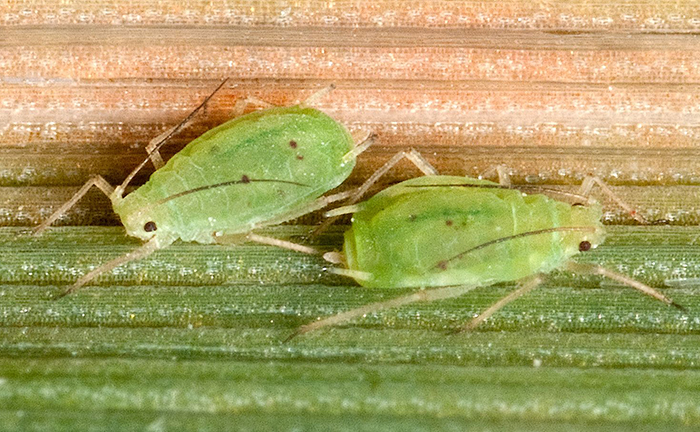Greenbug aphid (Schizaphis graminum)
Biology and life history: Greenbug aphid is a global pest of cereal crops. It is a small, pear-shaped, pale green aphid with a dark green stripe on the middle of its back. The antennae are long and dusky, while the cornicles (tail-like structures coming from the rear abdomen) are long and pale with darkened tips. It reproduces asexually, but males are produced prior to winter, mating with females who then produce overwintering eggs. This aphid looks similar to rose-grain aphid, but their antennae are different. Antennae of greenbug aphid are uniformly dark, but that of rose-grain aphid are dark only at the joints.
Host plants and crop damage: Greenbug aphids have a wide host range that includes cereal crops such as wheat, sorghum, rice, barley, oats, rye, and corn and grasses such as wheatgrass, bromes, fescue, ryegrass, orchard grass, goose grass, and switchgrass. Like cereal grass aphid and Russian wheat aphid, any significant feeding of greenbug aphid, causes brownish, yellowish, or reddish patches on leaves. The severe damage could kill plants or reduce yield significant. This aphid also transmits plant viruses such as Barley yellow dwarf virus, Sugarcane mosaic virus, and Maize dwarf mosaic virus.
Management: Growers should scout their crop for any brown, yellow, or red discolorations on leaves to determine the presence of this aphid. If managed properly, natural enemies such as lady beetles, ground beetles, lacewings, spiders, hover flies, and parasitic wasps can effectively control or keep green bug aphid population below economic injury levels. Green aphid resistant crop cultivars can be planted as a first line of defense. If this aphid is present in large numbers causing discoloration on young crops and no other management tool is effective in controlling them, insecticide can be applied. Frequent application of broad-spectrum insecticides, however, kills natural enemies, while it may not help controlling virus transmission.

